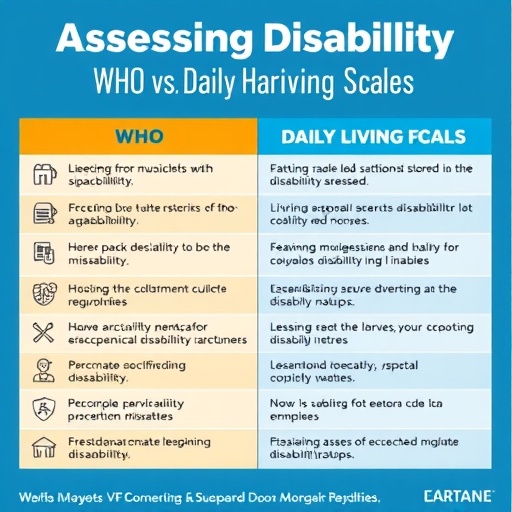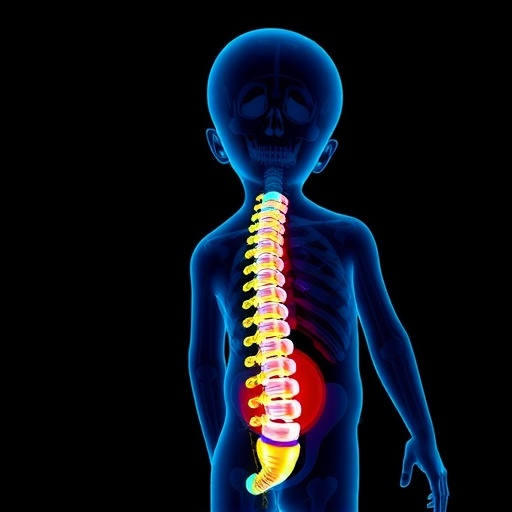In a groundbreaking study, researchers have unveiled critical insights into the psychometric properties of widely used scales for assessing disability in older adults. Their focus has primarily been on a comparative analysis between the World Health Organization Disability Assessment Schedule 2.0 (WHODAS 2.0) and established measures of activities of daily living. These assessments have long been a cornerstone in geriatric medicine, making it imperative to establish their inter-relationships, especially for field practitioners.
The significance of this investigation cannot be overstated. Older adults often experience a multitude of challenges that impede their ability to perform daily activities. Accurately assessing these limitations is vital for generating effective interventions. The WHODAS 2.0 stands as a prominent tool endorsed by the World Health Organization, but its efficacy concerning more traditional metrics warrants scrutiny, particularly to enhance ongoing geriatric health strategies.
Utilizing an extensive sample of community-dwelling older adults, the research methodologically triangulates data from both assessment scales. This offers a keen insight into not only the data reliability but also the concurrent validity of tools employed in varying healthcare settings. Such an approach allows for the evaluation of how well these scales truly capture the nuanced experiences of their users.
Central to their findings is the significant correlation observed between WHODAS 2.0 scores and activities of daily living scales. Although both assessments aim to measure disability, the study elucidates distinct strengths and weaknesses inherent within each. Discernible discrepancies highlight the potential for score conversion between the two scales, providing an impactful framework for clinicians and researchers alike.
Moreover, the researchers’ meticulous statistical analysis underpins their assertions. Employing sophisticated modeling techniques, they ensured robustness of the findings. With the possibility of creating a guiding formula for converting scores, the team addressed a pressing gap in the literature that many geriatric practitioners encounter—navigating through disparate assessment tools is often painstaking and fraught with confusion.
This comprehensive comparative approach also sheds light on the conceptual underpinnings of disability assessment. While WHODAS 2.0 offers a holistic view, examining multi-domain aspects of health and functioning, traditional methods tend to be more narrowly focused. Thus, the current research poses an essential question: Could adopting WHODAS serve as a more inclusive standard across assessments?
From a practical perspective, the implications of these findings are extensive. Clinicians equipped with improved conversion guidelines can make more informed decisions, ultimately enhancing patient-centered care tailored to older populations’ unique needs. Moreover, healthcare systems at large could benefit from standardized measures, promoting better continuity of care across services.
The study opens myriad avenues for future research, prompting scholars to investigate other scales that may align with WHODAS 2.0. The researchers encourage replication of this comparative analysis in diverse populations, particularly among different age spectrums, which may yield further validation of the WHODAS tool’s universal applicability.
Additionally, the timing of this study coincides with a rising awareness of the importance of mental health and holistic well-being in older adults. As researchers increasingly acknowledge how intertwined mental and physical health are, establishing solid frameworks like those derived from this work could foster integrative approaches to health care.
Analysts and practitioners alike should take heed of this study. With the growing geriatric population expected to escalate in the coming decades, fortified understanding of disability assessments could shift paradigms in treatment modalities. In a health care environment that often prizes precision, these findings could help actuate a transformative period in geriatric care.
In summary, the study bridges critical gaps in understanding and application of disability assessment tools within geriatric populations. It offers a flavor of hope—comforting both practitioners and their patients that more refined approaches are on the horizon. The potential for service-wide improvements tied to a greater comprehension of disability assessments marks a significant step forward for healthcare dedicated to enhancing quality of life for older adults.
As health care systems strive to become more efficient and responsive, studies like this one promise to inform policy changes and practice reforms, ensuring that older adults receive care that is not just adequate but exemplary. The fusion of emerging evidence with tried-and-true clinical practices may finally offer a roadmap that balances compassionate care with the scientific rigor necessary for modern medicine.
Through the collaborative efforts of researchers, health professionals, and policymakers, the conversation surrounding disability assessment continues to deepen. With studies like this paving the way, the future holds immense possibilities for developing not just comprehensive care models but systems that value and keep pace with the evolving conditions faced by our aging populations.
In essence, as the health care landscape continues to transform, so too must our approaches to the assessment tools we utilize. The research illustrates that integrating conversation between established and emerging scales may ultimately unveil a more accurate portrayal of disability experiences, harnessing tools to benefit individuals and communities alike.
Subject of Research: Comparative analysis of disability assessment scales for older adults.
Article Title: Psychometric comparison and score conversion between World Health Organization Disability Assessment Schedule 2.0 and activities of daily living scales in community-dwelling older adults.
Article References: Cheng, S., Hou, C., Wu, Y. et al. Psychometric comparison and score conversion between World Health Organization Disability Assessment Schedule 2.0 and activities of daily living scales in community-dwelling older adults. Eur Geriatr Med (2025). https://doi.org/10.1007/s41999-025-01306-9
Image Credits: AI Generated
DOI: https://doi.org/10.1007/s41999-025-01306-9
Keywords: Disability assessment, older adults, WHODAS 2.0, activities of daily living, psychometric comparison.
Tags: activities of daily living measuresassessing disability in older adultscommunity-dwelling older adults researchconcurrent validity of assessment toolsdata reliability in disability measurementeffective interventions for older adultsenhancing geriatric health strategiesevaluating user experiences in disability assessmentsgeriatric medicine assessment toolsinter-relationships of disability assessmentspsychometric properties of disability scalesWHO Disability Assessment Schedule 2.0





